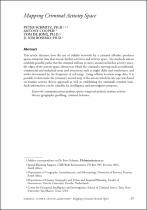JavaScript is disabled for your browser. Some features of this site may not work without it.
- ResearchSpace
- →
- Research Publications/Outputs
- →
- Journal Articles
- →
- View Item
| dc.contributor.author |
Schmitz, P

|
|
| dc.contributor.author |
Cooper, Antony K

|
|
| dc.contributor.author |
De Jong, T

|
|
| dc.contributor.author |
Rossmo, DK

|
|
| dc.date.accessioned | 2020-10-27T10:28:00Z | |
| dc.date.available | 2020-10-27T10:28:00Z | |
| dc.date.issued | 2015-07 | |
| dc.identifier.citation | Schmitz, P. et al. 2015. Mapping criminal activity space. Journal of Intelligence & Analysis, vol. 22(3): 67-94 | en_US |
| dc.identifier.uri | http://www.ialeia.org/publications-resources/ialeia-library/journal.html | |
| dc.identifier.uri | https://www.researchgate.net/publication/318902398_Mapping_Criminal_Activity_Space | |
| dc.identifier.uri | http://hdl.handle.net/10204/11636 | |
| dc.description | Article published in Journal of Intelligence & Analysis, vol. 22(3): 67-94 | en_US |
| dc.description.abstract | This article discusses how the use of cellular networks by a criminal offender produces spatio-temporal data that reveals his/her activities and activity space. The methods aim to establish possible paths that the criminal will use to move around in his/her activity space; the edges of the activity space; districts in which the criminal is moving such as residential, commercial and industrial areas and attractions such as night clubs and warehouses; and nodes determined by the frequency of cell usage. Using cellular location usage data, it is possible to determine the criminal’s mental map of the area in which he/she operates based on routine activity theory approach as well as establishing the criminal’s comfort zone. Such information can be valuable for intelligence and investigative purposes. | en_US |
| dc.language.iso | en | en_US |
| dc.publisher | International Association of Law Enforcement Intelligence Analysts | en_US |
| dc.relation.ispartofseries | Worklist;14209 | |
| dc.subject | Crime patterns | en_US |
| dc.subject | Environmental criminology | en_US |
| dc.subject | Criminal behavioural geography | en_US |
| dc.title | Mapping criminal activity space | en_US |
| dc.type | Article | en_US |
| dc.identifier.apacitation | Schmitz, P., Cooper, A. K., De Jong, T., & Rossmo, D. (2015). Mapping criminal activity space. http://hdl.handle.net/10204/11636 | en_ZA |
| dc.identifier.chicagocitation | Schmitz, P, Antony K Cooper, T De Jong, and DK Rossmo "Mapping criminal activity space." (2015) http://hdl.handle.net/10204/11636 | en_ZA |
| dc.identifier.vancouvercitation | Schmitz P, Cooper AK, De Jong T, Rossmo D. Mapping criminal activity space. 2015; http://hdl.handle.net/10204/11636. | en_ZA |
| dc.identifier.ris | TY - Article AU - Schmitz, P AU - Cooper, Antony K AU - De Jong, T AU - Rossmo, DK AB - This article discusses how the use of cellular networks by a criminal offender produces spatio-temporal data that reveals his/her activities and activity space. The methods aim to establish possible paths that the criminal will use to move around in his/her activity space; the edges of the activity space; districts in which the criminal is moving such as residential, commercial and industrial areas and attractions such as night clubs and warehouses; and nodes determined by the frequency of cell usage. Using cellular location usage data, it is possible to determine the criminal’s mental map of the area in which he/she operates based on routine activity theory approach as well as establishing the criminal’s comfort zone. Such information can be valuable for intelligence and investigative purposes. DA - 2015-07 DB - ResearchSpace DP - CSIR KW - Crime patterns KW - Environmental criminology KW - Criminal behavioural geography LK - https://researchspace.csir.co.za PY - 2015 T1 - Mapping criminal activity space TI - Mapping criminal activity space UR - http://hdl.handle.net/10204/11636 ER - | en_ZA |






